Accepted Scientific Name: Copiapoa cinerea (Phil.) Britton & Rose
Cactaceae (Britton & Rose) 3: 86. 1922 [12 Oct 1922] Britton & Rose
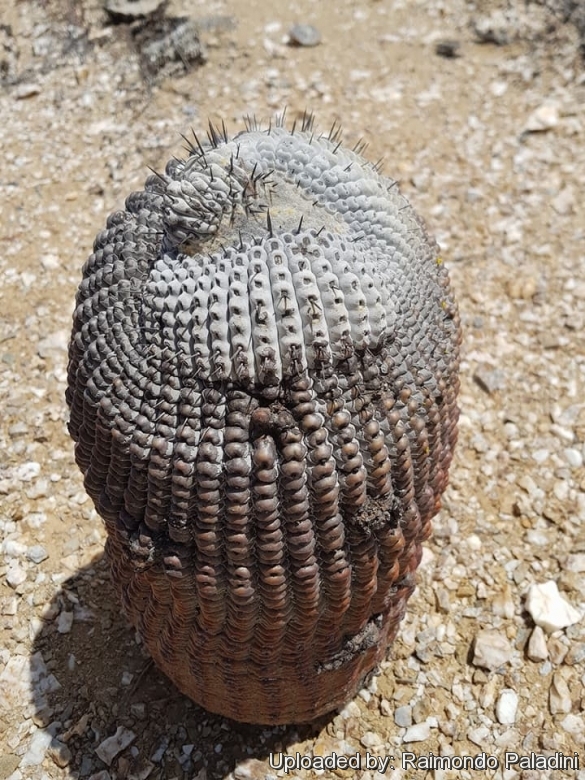
Copiapoa cinerea subs. columna-alba Photo by: Raimondo Paladini
Chile Jannuary 2018.
Origin and Habitat: II Region Antofagasta, Chile, It occurs in large numbers at numerous locations from the Pan de Azucar in the south to just south of Taltal in the north, making impressive stands, resembling a marching army.
Habitat: Coastal areas from sea level up to 500 m in altitude. The plants obtain water mainly from condensation (Coastal fog/camanchaca) as rain is very rare. The plants grows in areas nearly devoid of other vegetation and exposed, but receive protection from direct sun through coastal fog (camanchaca). They have found a niche in the quebradas that run towards the Pacific Ocean, but always stopping short from the beach localities that are reserved by Copiapoa longistamineaSN|1380]]SN|1389]] and Copiapoa taltalensisSN|1391]]SN|1391]]. At the same time, it is obvious that there are many similarities with Copiapoa cinereaSN|1389]]SN|1380]].
Synonyms:
See all synonyms of Copiapoa cinerea
Description: Usually solitary, forms white columns. All the plant in habitats lean markedly northward toward the sun following the direction of predominant wind, leading to the illusion that the entire landscape is tilted, This behaviour has been explained as a tactic by which the cactus minimizes the surface area exposed to the direct rays of sun. Thus the sun hits the woolly bent-over top of the cactus at an 90° angle, with the long trunk receiving only indirect sun. This species is more decorative than Copiapoa cinereaSN|1380]]SN|1380]] and one of the showiest of all cacti.
Note: This appears to be a very variable species.
Stem: Variable 50-75 cm tall, 10-20 cm in diameter, epidermis covered with a thick stratum of ashy-white pruine (it is often more white than the Copiapoa cinereaSN|1380]]SN|1380]]). Apex flattened with abundant yellow-orange or grey wool and without spines.
Ribs: 27-47, depressed, obtuse and tuberculated, approx 1 cm wide, 5-7 mm tall. Inter-ribs suture wavy.
Areoles: Small (diameter 2-3 mm), oblong, with yellow-orange wool (later becoming grey) recessed within the lower part of tubercle, 4-8 mm apart.
Central spines: 1-3 sub-erected, strong, up to1-2 cm long, black, brown or amber-yellow (never grey). Often the young plants are completely spineless.
Radial spines: 4-5 thin and arching, 5-8 mm long. Normally not present in adult specimen.
Roots: Not napiform.
Flowers: Apical, funnel form, small (2-3 cm long), yellow, scentless. Tube 7-15 mm long, pale-yellow with few thin, red tipped scales. Nectar chamber up to 4 wide, 2 mm deep and open. Lower filaments 15-18 mm long inserted at the base of the nectar chamber, upper filaments up to 10 mm long on the wall of the tube. Filaments and anthers pale yellow. Style up to 2 cm long not surpassing the stamens, stigma lobes 10, golden-yellow. 7 - 14 tepals, 10-12 mm long, 3-5 mm broad rounded, pale yellow, not tinged in red.
Fruit: Deeply concealed within the apical wool, 7-10 mm in diameter, round or egg-shaped, pale green reddening toward the apex, almost naked with only few (3-4 mm long) scales. Almost completely dry at maturity, deihscence capsular (less pulpy than in Copiapoa cinereaSN|1380]]SN|1380]]).
Seeds: Shining-black. 1,2 mm long, 0,6 mm large, 0,5 mm thick. Covered with very fine flattened tubercles, hilum oval white.
Bibliography: Major references and further lectures
1) Edward Anderson “The Cactus family” Timber Press, Incorporated, 2001
2) James Cullen, Sabina G. Knees, H. Suzanne Cubey "The European Garden Flora Flowering Plants: A Manual for the Identification of Plants Cultivated in Europe, Both Out-of-Doors and Under Glass" Cambridge University Press, 11/Aug/2011
3) David R Hunt; Nigel P Taylor; Graham Charles; International Cactaceae Systematics Group. "The New Cactus Lexicon" dh books, 2006
4) N. L. Britton, J. N. Rose “The Cactaceae. Descriptions and Illustrations of Plants of the Cactus Family.” Volume 4, The Carnegie Institution of Washington, Washington 1923
5) Urs Eggli, Leonard E. Newton “Etymological Dictionary of Succulent Plant Names” Birkhäuser 2004.
6) F.Ritter “Kakteen Südamerika” 3: 1072 1980.
7) Graham Charles “Copiapoa” Cirio Pub. Services, 1999
8) Adriana Hoffmann “Cactáceas en la Flora Silvestre de Chile” 1st edition, 1989
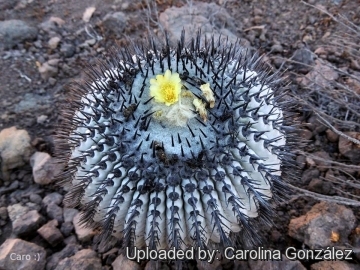 - Blooming habit at Antofagasta, Chile. Photo by: Carolina González
- Blooming habit at Antofagasta, Chile. Photo by: Carolina González Copiapoa columna-alba. Chile Jannuary 2018. Photo by: Raimondo Paladini
Copiapoa columna-alba. Chile Jannuary 2018. Photo by: Raimondo Paladini Copiapoa columna-alba (areoles in habitat) Photo by: Carolina González
Copiapoa columna-alba (areoles in habitat) Photo by: Carolina González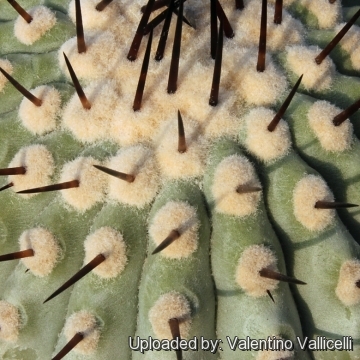 Copiapoa columna-alba (areoles in cultivation) Photo by: Valentino Vallicelli
Copiapoa columna-alba (areoles in cultivation) Photo by: Valentino Vallicelli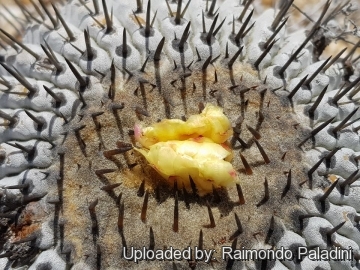 Copiapoa cinerea subs. columna-alba Photo by: Raimondo Paladini
Copiapoa cinerea subs. columna-alba Photo by: Raimondo Paladini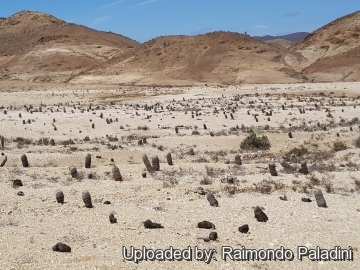 Copiapoa columna-alba. Habitat, Chile, Jannuary 2018. Photo by: Raimondo Paladini
Copiapoa columna-alba. Habitat, Chile, Jannuary 2018. Photo by: Raimondo Paladini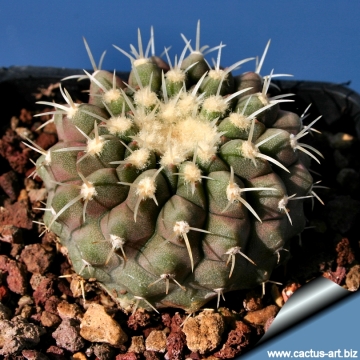 Copiapoa cinerea subs. columna-alba Photo by: Cactus Art
Copiapoa cinerea subs. columna-alba Photo by: Cactus Art Copiapoa cinerea subs. columna-alba Photo by: Raimondo Paladini
Copiapoa cinerea subs. columna-alba Photo by: Raimondo PaladiniCultivation and Propagation: This extremely slow growing cactus is kept for the beauty of its form. It must be protected from excessive heat and sun in summer, and seems to do best in cultivation with a bit of shade. It requires light but regular waterings in summer, but let the soil mix dry between waterings, Prone to rot if over-watered. Needs good drainage. Keep warm and dry in winter (10°C) to avoid rot. Not highly tolerant of a great deal of frost. (Frost tolerance 0°C)
Propagation: Seeds (or offsets if available), Grafting is often used to speed growth rate and to create a back-up to plants in collection.
Your Photos
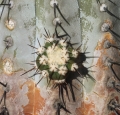
by Valentino Vallicelli
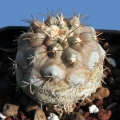
by Valentino Vallicelli

by Cactus Art

by Valentino Vallicelli

by Carolina González























